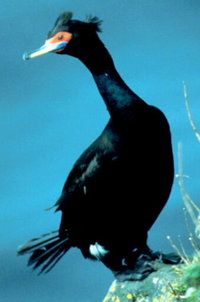Cormorant
|
|
| Cormorants | ||||||||||
|---|---|---|---|---|---|---|---|---|---|---|
 Red-faced Cormorant | ||||||||||
| Scientific classification | ||||||||||
| ||||||||||
| Genera | ||||||||||
|
The Phalacrocoracidae family of birds is represented by over thirty species of cormorants and shags. All but three are in the genus Phalacrocorax, the exceptions being the Galapagos Flightless Cormorant, the Kerguelen Shag and the Imperial Shag.
The names "cormorant" and "shag" were originally those of the two species of the family found in Great Britain, Phalacracorax carbo (the Great Cormorant) and P. aristotelis (the Common Shag). "Shag" refers to the bird's crest.
As other species were discovered by English-speaking sailors and explorers elsewhere in the world, some were called cormorants and some shags, depending on whether they had crests or not. Sometimes the same species is called a cormorant in one part of the world and a shag in another, e.g. the Great Cormorant is called the Black Shag in New Zealand (the birds found in Australasia have a crest that is absent in European members of the species).
Christopher Isherwood was obviously unaware of the distinction when he began a poem, "The common cormorant (or shag)/lays eggs inside a paper bag". His information about the bird's nesting habits shouldn't be relied on either.
Cormorants and shags are medium-to-large seabirds, usually with mainly dark plumage and areas of coloured skin on the face which are bright blue, orange, red or yellow. The bill is long, thin, and sharply hooked. Their feet are four-toed and webbed, a distinguishing feature among the Pelecaniformes order.
They are coastal rather than oceanic birds, and some have colonised inland waters. They range around the world, except for the central Pacific islands.
All are fish-eaters, dining on small eels, fish, and even water snakes. They dive from the surface, though many species make a characteristic half-jump as they dive, presumably to give themselves a more streamlined entry into the water. Under water they propel themselves with their feet.
After fishing, cormorants go ashore to dry their wings by holding them out in the sun. Unusually for a water bird, their feathers are not waterproofed. This may help them dive quickly, since their feathers do not retain air bubbles.
Cormorants are colonial nesters, using trees, rocky islets, or cliffs. The eggs are a chalky-blue colour. There is usually one brood a year. The young are fed through regurgitation.
Humans have historically exploited cormorants' fishing skills, in China and Japan, where they have been trained by fishermen. Traditional cormorant fishing can be watched in the city of Inuyama, in Aichi Prefecture in Japan. In Guilin, China, cormorant birds are famous for fishing on the shallow Lijiang River.
This group is related to other Pelecaniformes as below:
- ORDER PELECANIFORMES
- Family Sulidae: gannets and boobies
- Family Phalacrocoracidae
- Genus Phalacrocorax
- Brandt's Cormorant, Phalacrocorax penicillatus
- Double-crested Cormorant or White-crested Cormorant, Phalacrocorax auritus
- Great Cormorant, Phalacrocorax carbo
- Neotropic Cormorant, Phalacrocorax brasilianus
- Olivaceous Cormorant or Mexican Cormorant, Phalacrocorax olivaceus
- Pelagic Cormorant or Baird's Cormorant, Phalacrocorax pelagicus
- Red-faced Cormorant, Phalacrocorax urile
- Guanay Cormorant , Phalacrocorax bougainvillii (off Peru, guano collected from nesting colonies of this bird is used to produce internationally traded commercial fertilizer)
- Little Black Cormorant, Phalacrocorax sulcirostris
- Indian Cormorant, Phalacrocorax fuscicollis
- Cape Cormorant, Phalacrocorax capensis
- Socotran Cormorant, Phalacrocorax nigrogularis
- Wahlberg's Cormorant, Phalacrocorax neglectus
- Temminck's Cormorant, Phalacrocorax capillatus
- Common Shag, Phalacrocorax aristotelis
- Rock Shag, Phalacrocorax magellanicus
- Long-tailed Cormorant, Phalacrocorax africanus
- Little Cormorant, Phalacrocorax niger
- Pygmy Cormorant, Phalacrocorax pygmaeus
- Pitt Cormorant or Featherstone's Shag Phalacrocorax featherstoni
- Pied Cormorant or Yellow-faced Cormorant, Phalacrocorax varius
- King Shag, Phalacrocorax carunculatus
- Black-faced Cormorant, Phalacrocorax fuscescens
- Kerguelen Cormorant, Phalacrocorax verrucosus
- Red-footed Shag, Phalacrocorax gaimardi
- Spotted Cormorant or Spotted Shag, Phalacrocorax punctatus
- White-bellied Shag, Phalacrocorax albiventer
- Little Pied Cormorant, Phalacrocorax melanoleucos
- Stewart Shag, Phalacrocorax chalconotus
- Chatham Shag, Phalacrocorax onslowi
- Auckland Shag, Phalacrocorax colensoi
- Campbell Shag, Phalacrocorax campbelli
- Bounty Shag, Phalacrocorax ranfurlyi
- Genus Leucocarbo
- Imperial Shag, Leucocarbo atriceps (Previously Antarctic, South Georgian, Heard, Crozet, and Macquarie Shags, Phalacrocorax bransfieldensis, georgianus, nivalis, melanogenis, and purpurascens.)
- Kerguelen Shag, Leucocarbo verrocosus (Previously P. verrocosus.)
- Genus Nannopterum
- Flightless Cormorant, Nannopterum harrisi (confined to the Galapagos Islands where, through evolution, its wings have shrunk to the size of a penguin's flippers)
- Genus Phalacrocorax
- Family Fregatidae: frigatebirds
- Family Anhingidae: Anhinga and darters
- Family Phaethontidae: tropicbirds
The King Shag of New Zealand has a number of races previously considered as full species.
The Spectacled Cormorant, Phalacrocorax perspicillatus, is extinct.
For an alternative scientific classification, see Sibley-Ahlquist taxonomy.
External links
- Cormorants (Phalacracorax carbo) in the British Isles (http://www.swuklink.com/BAAAGARU.php)da:Skarver
de:Kormorane es:Cormorán fr:Cormoran he:קורמורן nl:Aalscholvers ja:ウ科 (Sibley) pl:Kormoranowate fi:Merimetsot sv:Skarvar zh:鸬鹚科
